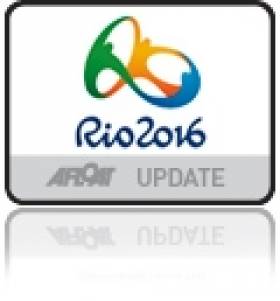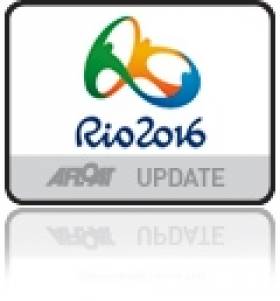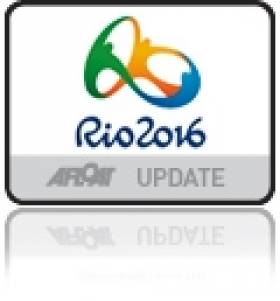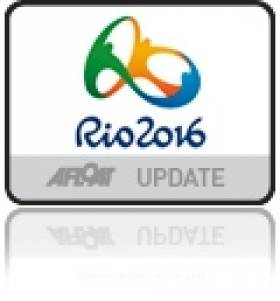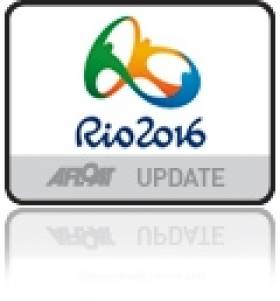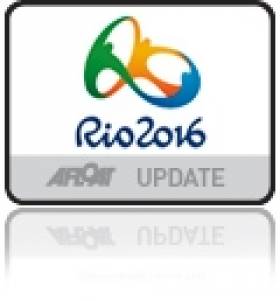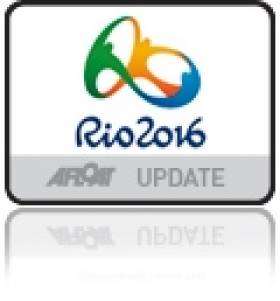Displaying items by tag: Rio
All to Play for at IFDS Disabled Sailing Worlds in Kinsale
#ifds – Today the wind was up and the sun was shining and from early on there was certainly no sign of competitors and officials relaxing with coffee around the Kinsale Yacht Club writes Claire Bateman. Every one had gone to sea fully ready for action and determined to get the most out of the day. They were not to be disappointed.
The weather forecasters had got it spot on and a nice south westerly wind of about ten knots filled in and the Race Officers were anxious to get up and running.
Your intrepid photographer and scribe had been slightly delayed getting to Kinsale this am and as a result were in fact last leaving the marina . However, we managed to arrive bang on time and went first to the Sonar fleet who were in sequence. Here all praise must be given to the Race Officers and mark laying boats for all the fleets and they should certainly sleep well tonight. The slickness and timing of the entire operation had to be seen to be believed. In fact the two Race Officers were starting their races exactly on their scheduled times.
It was good to see Irish IFDS President, John Twomey getting off to an excellent start and rounding the first windward mark in third place. The Sonar Class have now completed six races and it is the French team of Bruno Lourdren, Eric Flageul and Nicolas Vimont-Vicary who are current leaders on seven points after one discard. They are followed by NED 1 helmed by Udo Hessels and crewed by Mischa Rossen and Marc el van de Veen on eighteen points. In third place is AUS 1 helmed by Colin Harrison, crewed by Jonathon Harris and Russell Boaden on twenty points. The top Irish score in the class is IFDS President John Twomey crewed by Ian Costelloe and Anthony Hegarty on thirty points. .
In the SKUD Class The battle is between Alexandra Rickham and crew Niki Birrell from the UK , the Italian team led by Marco Gualandrias and John Mcroberts of Canada in first, second and third places respectively. The British team are now counting four first places with the Italians counting a first and three seconds and Canada counting two seconds and two thirds.
Meanwhile in the 2.4mR class Heiko Kroger of Germany had two wins today and results are showing him in second place with Bijilard Guus NED in first place However, the other NED competitor Barend Kol is third place on equal points with Heiko Kroger while in the latter two races today Helena Lucas of Britain, Gold Medalist London 2012 was getting into her stride with a second and a first and it would be a foolish person that would write her off at this stage.
So, it is all to play for tomorrow and will make for a very interesting and nail biting day indeed.
Kinsale Disabled Sailing IFDS Worlds Underway
#ifds – The practice race for the IFDS World Paralympic Sailing Championships was designated for today at 12 noon writes Claire Bateman.
Well, what a day it turned out to be. Before getting anywhere near Kinsale Yacht Club the town was buzzing.
There was a sense of something big happening on the day and I don't think a single person can have been disappointed.
Closer towards the yacht club the excitement became more and more palpable but everything seemed extremely orderly and well in hand. Competitors, officials and all connected with the organisation of the event went about their business in a very methodical manner as everything had obviously been planned with military precision for months under the stewardship of John Stallard, a former KYC Club Commodore and a veteran of many events of which Kinsale YC can be justly proud.
The seagoing vista was practically indescribable with brilliant sunshine, a nor westerly breeze making for wonderful sailing opportunities with great flat water sailing on gleaming waters, and all surrounded by the magnificent scenery that is synomous with Kinsale. One very noticeable item was the fact that every competitor had a smile and wave for everyone and that is certainly more than one could expect from many of the forty footers sailing in competition. None of this is to say that the calibre of competition for this event is not exceptionally high as these fleets rank among some of the most competitive in the world.
In the Sonar class, London 2012 Bronze medallist Norway's Aleksander Wang-Hansen did not compete in the practice race however the London 2012 Gold medallist Udo Hessels started and finished mid-fleet. Corkman Paul McCarthy on IRL697 had a good race finishing in second place but the race was won by USA's Rick Doerr and his crew. Irish Paralympian John Twomey, Anthony Hegarty and Ian Costello finished in 7th place.
On Course B, in the singlehanded 2.4mR class, 39 of the 46 competitors took part in today's practice race with Germany's Heiko Kroeger, who won silver at London 2012, getting the bullet. He was followed by Damien Seguin from France and Italian Antonio Squizzato in third. Helena Lucas from the UK who won Gold in Weymouth did not participate in today's race.
Also on Course B the nine Skud 18 sailors completed their race with John McRoberts from Royal Victoria Yacht Club in Canada taking line honours. The Netherlands' Vera Voorbach was second and Italy's Marco Gualandris third.
It would of course be impossible to name all the outstanding world championship names competing at Kinsale. It will be of huge interest to see how everybody fares and all that remains is to wish each and everyone fair winds and good sailing for the week.
The opening ceremony took place at 6pm this evening
Olympic Sailing Team Sign Rio 2016 Sponsor
#rio – In a continuation of its relationship with Irish high performance sailing, the Irish Olympic sailing team announced a new deal for the Rio de Janeiro Olympic Regatta in 2016 with Irish exploration firm Providence Resources in Dublin this morning.
A team spokesperson described the size of the sponsorship as a 'significant six figure sum'.
Golden girl Annalise Murphy (23) and other members of the team were present when the city centre announcement was made with Providence Resources Chief Executive, Tony O'Reilly.
Annalise, who lost out on a medal in the final moments of her last race in Weymouth, has got her 2016 campaign off to a flying start winning two of three Eurocup events, earning her May's Afloat Sailor of the Month award.
Murphy won both the Italian Lake Garda and Dutch rounds of the Eurocup to put her in top form for the Laser European Championships to be staged, for the first time, in her home waters of Dun Laoghaire next month at the National Yacht Club.
Annalise was joined for today's press event by June's Sail for Gold medal winner 49er sailor Matt McGovern, Laser solo sailor James Espey and Paralympian John Twomey.
The Irish sailing team had their most successful Olympics for thirty years in 2012 with 4th, 10th and 14th finishes but did not win a medal as team officials had predicted.
The sponsorship from Providence announced today means the team can spend more time at the Rio venue, a much more expensive proposition than Weymouth.
Currently, the 2016 sailing team members includes:
Olympic
Annalise Murphy, (Laser Radial)
Ryan Seaton & Matt McGovern, (49er)
James Espey (Laser)
Paralympic
John Twomey (Sonar)
Ian Costello (Sonar)
A number of other campaigns are currently in training to reach qualification standard for 2016, including two campaigns in the new all-female class 49er FX, namely Tiffany Brien and Saskia Tidey and Claudine Murphy and Andrea Brewster.
Meanwhile, Royal Cork Star sailor Peter O'Leary could still get a chance to sail in the keelboat again but only if the venerable class is reinstated in the Olympic fleet line-up, a question everyone in Olympic circles is asking.
Sailing at the Rio Games will be at Marina da Gloria in Guanabara Bay, where, ominously, forecasters say winds can be 'noxiously light and flukey'.
Annalise Sails for Three Out of Three as Irish Sailors Head for Sail for Gold, Weymouth
#SailforGold– Irish Olympic Sailing sensation Annalise Murphy is back in Weymouth to make it three out of three in the Eurosaf Champions Sailing Cup series after already taking gold at the first two events in Italy and Holland.
She is joined by four of her London 2012 Olympic team mates this weekend to begin competing at the Sail for Gold Regatta. Murphy (Laser Radial) is joined by Ryan Seaton and Matt McGovern (49er) and James Espey (Laser) will begin racing on Sunday in what will be the third of five EUROSAF installments
This will be the first regatta of the 2013 season for Seaton and McGovern who finished 14th overall at the Games last year. Back in familiar waters after months of physical and mental training, the duo are eager to once again feel the adrenaline of elite competition as they begin their campaign towards the Rio 2016 Olympics. Up against some of the top international 49er teams, the Northern Irish men will be looking to shake off the cobwebs after an extended break from competition.
Also campaigning for the Rio Games and competing for the first time in the 49er FX class will be two new all-female pairings. Claudine Murphy, older sister of Annalise, has teamed up with Andrea Brewster while Tiffany Brien and Saskia Tidey, will be sailing the other Irish entry for the new Olympic class.
Annalise Sweeps to Gold Medal on Lake Garda
A return to form for Annalise Murphy saw the Rathfarnham sailor win Gold today at the Italian Olympic Week 2013 on Lake Garda, the first round of the new Eurosaf sailing world cup.
The Dubliner, the Irish Sailor of the Year was sailed down the fleet on the first leg of the course in a tactical move by a medal race opponent but caught the leaders in the 6-boat fleet on the first downwind leg and then led the race in the blowy lake conditions.
Admittedly the win comes against a fleet not as strong as the recent world cup series but it will nevertheless boost her confidence for events later in the season including the Laser European Championships at her home club, the National Yacht Club in Dun Laoghaire in September.
Italian Olympic Week is the first regatta in the Eurosaf series. In total five regattas will be sailed over the summer months with the next regatta, Delta Lloyd starting in just eight days in the Netherlands on 21 May, followed by Sail for Gold in Weymouth and Kieler Woche in June and finally Semaine Olympique Francaise in la Rochelle in the autumn.
A new format for the medal race was trialed this week at Italian Olympic Week whereby the fleet is divided in to Gold and Silver after two days with the top six boats in the Gold fleet progressing to the Medal Race on the final day. This new format will be officially adopted for Rio 2016.
New Irish Women's Skiff Campaign Launched
Annalise Murphy's older sister Claudine has announced plans to join Annalise on the road to Rio's Guanabara Bay in the latest Irish Olympic women's skiff sailing campaign.
Claudine has teamed up with former British triallist Andrea Brewster in a bid for the Irish 49erfx slot.
The pair will battle Tiffany Brien and Saskia Tidey who also seek the single Irish place.
Click for the very latest update on Claudine and Andrea's campaign
O'Leary Takes a Win in Big Breeze at Bacardi Cup
#bacardicup – The Irish team of Peter O’Leary and Rodney Hagebols (bow 73) are eighth overall after four races at the 86th Bacardi Cup after winning the fourth race in a day of high drama on Biscayne Bay yesterday.
As temperatures hit the high 70s on the third day of racing, the fourth race of the series got underway in 15 knots of breeze, and, with the black flag rule in effect, six boats were disqualified. Wind gusts over 25 knots contributed to 11 boats not finishing the day's single race, including two with broken masts.
Lars Grael and Mario Lagoa (BRA) finished third in the race allowing them to increase the point spread while continuing their hold on first place in the overall standings with 17 points. The Italian team of Diego Negri and Frithjof Kleen finished second in the race and are just nine points out of first. They are followed in the overall standings by 2003 Rolex Yachtsman of the Year Augie Diaz (Miami, Fla.) and Arnis Baltins, who added a 22 to their previous finishes of 3-1-10 for 36 points. Alessandro Pascolato and Henry Boening (BRA) are fourth overall with finishes of 18-8-6-8 for 40 points, and the Canadian team of Brian Cramer and Cam Lymburner round out the top five with 9-7-18-7 for 41 points.
The Italian team of Diego Negri and Frithjof Kleen (bow 52) and Florida's 2012 Olympians Mark Mendelblatt and Brian Fatih (bow 19)
"I have not been racing since last April and needed to dust off the first two days and find the confidence that is needed to race in this highly competitive regatta," said Diego Negri. "Our results are on the rise and I think we're doing a fine job and having fun at the same time. This is my third Bacardi Cup and I'm enjoying it very much. Lars is a very tough competitor. He is one of the best in the world and has shown he is able to race well in both light and stronger wind conditions. I'm looking forward to keep having fun and post good results. If the wind will be as today, I think we might have a chance to win the Cup. It would be a significant achievement."
Although Irish Olympian Peter O'Leary and Rodney Hagebols won today's race, they still carry 36 points earned in race two of the series (once five races have been completed, the scores will reflect each yacht discarding her worst race). With 50 points, they currently stand eighth overall, seven points behind defending champions Xavier Rohart and Pierre Alexis Ponsot (FRA).
"Windy for sure today, 20 plus average," said O'Leary. "Once we got going it was a proper Bacardi Cup regatta in which we stretched legs and hiked hard. The main challenge of the day was to stay in pressure and take advantage of the big breeze. We rounded the last mark in third and were able to beat the Italians on the line. Tomorrow is a lay day and then three more races to go. If we keep posting single digit results we have a chance. We had a bad day yesterday and it was nice to bounce back. Lars is showing to be consistent and is sailing smart... he is the one to beat."
Racing for the Star class resumes on Friday, March 9, after a planned lay day tomorrow. On Thursday, March 7, sailors in the Audi Melges 20, Melges 24 and Viper 640 classes, along with the J/70 class which makes its event debut, will get their first taste of competition on Biscayne Bay. Racing, for all classes, will conclude on Saturday, March 9.
During the event sailors will enjoy the hospitality lounge, BACARDI Rum tastings, as well as the daily prize giving for the top-three finishers and the final awards dinner. A special exhibit of America's Cup history and memorabilia will feature the work of Rhode Island-based photographer Cory Silken in the North Hall of the Coconut Grove Convention Center. The exhibits will be open to the public from noon to 7:00PM daily and are free of charge. The prestigious Coral Reef Yacht Club will coordinate on-water activities in collaboration with Biscayne Bay Yacht Club and Coconut Grove Sailing Club. The U.S. Sailing Center and Shake-A-Leg Miami will also support the event. Racing will be held on three separate courses approximately two miles out on Biscayne Bay.
More information on the BACARDI Miami Sailing Week and the 86th BACARDI Cup is available at www.MiamiSailingWeek.com and www.BacardiCup.com.
O'Leary Returns to the Star and Miami's Bacardi Cup
#bacardicup – Royal Cork and Baltimore's Peter O'Leary is heading for Florida and Bacardi Cup next week where he lines up against some of his London 2012 Olympic rivals for the first time since Weymouth.
The Star keelboat however is no longer an Olympic class and the prospects of its reinstatement appeared premature this week. In Miami O'Leary will be crewed by former training partner Rodney Hagebols.
This time last year, and the Olympics just months away, O'Leary and Burrows launched a new Star boat for Bacardi Cup and although the Irish pair were one time regatta leaders they were pipped for a second year running by a French team for overall honours.
Headlining a week-long one design regatta, headquartered in Coconut Grove, is the 86th Bacardi Cup. Among the 62 Star teams registered are some of the storied class's most notable. Leading the lineup are 2012 Star World Champions Xavier Rohart and Pierre-Alexis Ponsot (France), who are also the BACARDI Cup defending champions. They will face, among others, 1992 Finn Silver medalist Brian Ledbetter (Medina, Wash.) who has teamed with Canadian 2012 Olympian Tyler Bjorn; 2009 Star World Champion George Szabo (San Diego) sailing with Miami's Magnus Liljedahl, the 2000 world champion and Olympic Gold Medalist; two-time ('08, '12) Olympian Peter O'Leary (Ireland) with Rodney Hagebols (Australia); Rolex Yachtsman of the Year Augie Diaz (Miami, Fla.); and two-time ('88, '96) Tornado Olympic Medalist Lars Grael (Rio de Janeiro, BRA.
Racing for the Star class gets underway on Monday, March 4.
Starting on Thursday, March 7, the Stars will be joined on Biscayne Bay by sailors in the Viper 640, Audi Melges 20, and Melges 24 classes, along with the J/70 class which makes its event debut. Racing, for all classes, will conclude on Saturday, March 10.
More information here www.MiamiSailingWeek.com


























